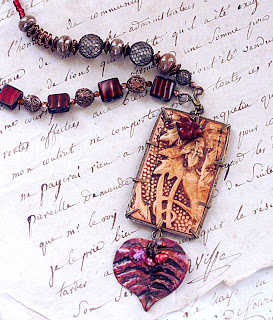Although my husband and I will soon be celebrating our 10th anniversary, we still count having each other as our “bestest” gift at Christmas. And we're both still healthy and fairly active and that is quite a lot to be thankful for at our ages.
But I would be remiss if I failed to thank each and every one of you who reads this blog for making my days so enjoyable as I write down my thoughts and observations, knowing that someone is actually out there who shares my passions and takes the valuable time to visit and comment. I am so thankful that I have many good friends online that I feel closer to than any I have ever made in my lifetime, although I have never met you in person. Can creativity operate in a vacuum? Probably, but it's not much fun. I treasure the ability to share my discoveries, experiments and musings with all of you and am humbled by your enthusiasm for them.
I'm just bubbling with new ideas I want to share with you -- some of them are already scheduled to be out there in a public way around March. My wish list this New Year of 2011 includes making it to a major bead show, where I can meet in person some of the creative friends I talk to almost daily online.Also in the works in the next few weeks is a major update to my studio space, so I can get my kiln going and play with metal clay, as well as set up my bench with my flexshaft drill and soldering station. It's time to add in metals to my polymer creations in a big way, something I've been planning for over a year. I've used some found metal pieces and some repoussé that Douglas makes for me but I've always had a better marriage of metal and polymer in mind for my designs. I'm so excited, I can hardly wait to get started!
Yesterday I played around with some old glass storage containers I found at a local yard sale. I plopped in some bits and bobs and built some seasonal tableaux with some of my latest polymer experiments.
Silver Leaves tableaux
Pinecone tableaux
Globes and Stones tableaux
"Red Fox" felted wool pin, from Under the Moon, Amanda Wiesenfeld, VT Handcrafters
Antique store find tool box, lovingly restored by Douglas
Present for both of us-- yipee! new techniques!
Polymer lentil bead from Mindy Jackson, Stray Cat Jewelry, VT Handcrafters
Lampwork bead from Wandering Spirit Designs -- present from my sis
And for a happy ending to the busted stove story, today I'm happily baking cupcakes and a pumpkin pie for Douglas. A wonderful repair technician named Gary from the Dead River Company in Woodstock, Vermont persevered through a snowstorm to repair my oven on Thursday night. Now, THAT'S customer service, Sears! I'm glad I went with a local company and supported my community.
Happy holidays to all and I'll see you again after the New Year!





















































